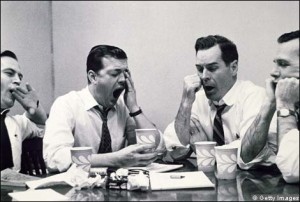YAWNING
IV. Sensory Afferents producing Yawning
A. Stimulation of Inspiration
1. Tissue O2 use àñ PCO2 and H+ in the blood
a. Central chemoreceptive neurons sensitive to ñ PCO2 and H+
i. ñ PCO2 and H+ in CSF
ii. ventrolateral surface of medulla
b. Chemosensitive area àñ Inspiratory area (DRG/NST)
i. Dorsal Respiratory Group (DRG) /
Nucleus of the Solitary tract (NST)
c. Apneustic Center neurons àñ DRG
i. promote inspiration
1) delay off signal of the inspiratory ramp
2) àñ intensity of breathing
ii. inhibited by pulmonary stretch
d. NST Þ phrenic nerve Þñ diaphragm
i. NST Þ intercostal nerves Þñ rib muscles
e. Pneumotaxic center = PRG àò Apneustic neurons
i. ... cyclically inhibits respiration
ii. PRG àò phrenic activity
2. But... ñ PCO2 or ò O2
a. do NOT Þñ yawning
i. Inspiration does occur during yawning
1) so, Þñ NST activity is necessary
a) Key component of autonomic control
ii. so... what is the sensory stimulus?
B. Afferents (inputs) to the NST include facial (VII), glossopharyngial (IX)
and vagus (X) nerves
1. chemoreceptors and mechanoreceptors
a. carotid bodies via glossopharyngial nerve
b. aortic bodies via vagus nerve
2. senory information from lungs, airways, pharynx
a. vagus and glossopharyngial nerves
C. NST projects to reticular formation (includes respiratory groups)
1. via phrenic/intercostal Þñ diaphragm/ribs
2. hypothalamus (including PVN)
3. CeA (central nucleus of the amygdala)
4. sympathetic preganglionic neurons
D. ò O2 in the PVN Þñ Yawning
1. PVN = paraventricular nucleus of the hypothalamus
a. stimulates sympathetic output via the NST
b. 1o site of CRF synthesis: begins endocrine stress cascade
i. CRF Þñ ACTH Þñ B/F
1) ACTH = AdrenoCorticoTropic Hormone
(from pituitary)
2) B/F = cortcosterone/cortisol
(steroids from adrenal cortex)
c. PVN produces oxytocin (OT) and vasopressin (AVP)
2. electrical stimulation of PVN Þñ Yawning
a. histamine Þ PVN Þñ Yawning
E. Yawning is initiated by widening the mouth and pharynx
1. open the jaw:
a. inferior alveolar nerve, trigeminal nerve (V), facial nerve (VII)
2. widen the pharynx:
a. pharyngial branch of the vagus nerve,
superior cervical ganglion, sympathetic fibers
i. Yawning caused by a transient ñ sympathetic arousal
F. Yawning is triggered by drowsiness
1. transition of arousal states
2. driven by circadian rhythms
a. circadian clock is the SCN (suprachiasmatic nucleus)
1) SCN projects directly to the PVN
a) stimulation of the PVN Þñ yawning
G. ... Drowsiness/SCN signal Þñ AVP ÞñPVN
1. PVN Þñ NST Þñ ciliospinal center C8-T2
a. ñ NSTÞcc C8-T2Þñ superior cervical ganglion
b. ñSCG Þñ postganglionic sympathetic fibers Þ
c. ñ sympathetic NE Þñ pharyngial widening
IV. Gating the Yawn
